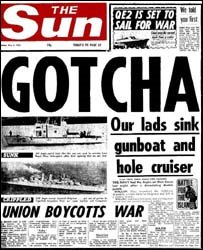HMS Conqueror

Conqueror returns to Faslane flying the 'Jolly Roger' to mark an enemy 'kill'.
HMS Conqueror was the third vessel of the Churchill class nuclear powered submarines and is famous for one major event that occurred in May 1982 during the Falklands War: sinking the Argentinean cruiser General Belgrano.
Conqueror, under the command of Cdr Chris Wreford-Brown, set sail from Faslane bound for the Falkland Islands on April 3 1982, a mere two days after the Argentines had invaded the islands. Arriving in the theatre of operations around the islands 21 days later, Conqueror's prime role was to find the Argentinean Aircraft carrier 25 de Mayo. The presence of the carrier in waters around the Falklands would have been dangerous for the British Task Force steaming south to liberate the islands.
In fact while Conqueror was operating to the south of the Falkland Islands, the 25 de Mayo was approaching from the north. On 30 April Conqueror located the Argentinean light cruiser General Belgrano (ex-USS Phoenix) off the Burdwood Bank, to the south of the islands. The British government, under the leadership of Margaret Thatcher, had imposed a 200 nautical mile exclusion zone around the Falkland Islands; any Argentinean ships entering that zone could expect to be attacked. But the General Belgrano, accompanied by two destroyers, was outside the zone. The British Task Force Commander Rear-Admiral Sandy Woodward gave the order for Conqueror to attack, but this was countermanded by Submarine HQ at Northwood. Admiral of the Fleet and Chief of the Defence Staff Sir Terry Lewin approached the British Cabinet to ask for a change in the rules of engagement in order to attack the cruiser.
Faced with the prospect of Conqueror losing the Argentine ships as they passed over the Burwood Bank (Conqueror's towed sonar array would probably have snagged on the underwater reef), the order from London came for Wreford-Brown to engage. The Cabinet were aware that both of the destroyers were armed with deadly ship-to-ship Exocet missiles and thought the General Belgrano may have been similarly armed.
It was feared that the General Belgrano was acting in concert with the 25 de Mayo to create a pincer attack on the British Task Force.
Conqueror launched three torpedoes, one of which struck the General Belgrano, virtually blowing the bow off, but causing no casualties. Another hit her just aft-amidships. The explosion blasted through two mess decks and ripped a 20m hole in the upper deck. It is estimated that 275 crew were killed in this blast.
| The explosions had put General Belgrano's electrics out of action, and with water pouring in through the hull, within 20 minutes of the attack it was clear that the cruiser was going to the bottom. With her two destroyer escorts leaving the scene to hunt for Conqueror, General Belgrano's commander Captain Hector Bonzo gave the order to abandon ship at 16:24. Although Argentine and Chilean ships rescued 770 men from the water, total Argentine losses were 323 men. |  |
The sinking was controversial for a number of reasons. It coincided with a peace initiative from the Peruvian President, though this would have been rejected by the British anyway. It also appears intelligence the General Belgrano was moving away from the Islands prior to Conqueror's attack was not passed to the Cabinet, though naval opinion considered this irrelevant given the nature of naval operations. Moreover, recent evidence has shown that the British Cabinet were aware of Argentinean design to launch the pincer attack on the Task Force.
Fact: after the sinking the Argentinean navy retreated to port and stayed there for the duration of the war. Therefore the sinking can be considered a decisive moment in the war.
Fact: Conqueror is the only nuclear powered submarine to have engaged an enemy vessel with torpedoes.
Fact: Conqueror's periscope can be seen in the Royal Navy's museum in Gosport.
Fact: as with all Royal Navy submarines that score a 'kill', Conqueror flew the Jolly Roger on her return to Faslane.

Fact: the British tabloid press reacted in jingoistic style, The Sun leading the way with their infamous "Gotcha" headline. In fact the headline only appeared on early editions of the paper and was quickly pulled.
HMS Conqueror (S48) Particulars
Built by Cammell Laird in Birkenhead, commissioned 1971.
Commissioned: 1971
Decommissioned: 1990
Displacement: 4,900 tonnes submerged
Length: 86.9 m
Beam: 10.1 m
Draught: 8.2 m
Propulsion: One nuclear reactor, one shaft
Speed: 28 knots submerged
Complement: 103
Armament: 6 x 533 mm tubes capable of firing:
Mark 8 torpedoes
Tigerfish torpedoes
RN Sub Harpoon Missiles
Agree or disagree with this? Make up your own mind:
Naval Historian Eric Grove's view
Margaret Thatcher's memoirs of the incident
Guardian Interactive guide to the Falklands war
Thatcher in the dark on sinking of Belgrano, The Times
Read more >>
Eighteen years after the sinking of the General Belgrano, Narendra Sethia travels to Argentina to meet the men he tried to kill :
Narendra Sethia, HMS Conqueror. (The Guardian)
Next week choose from:
SMS Emden: the infamous German commerce raider from WWI
USS Constitution: 'Old Ironsides', the heavy American frigate from the War
of 1812
IJN Yamato: one of two 65,000-ton behemoths built by Japan during WWII
Vote by leaving comments!

1 comment:
Emden please!
Post a Comment